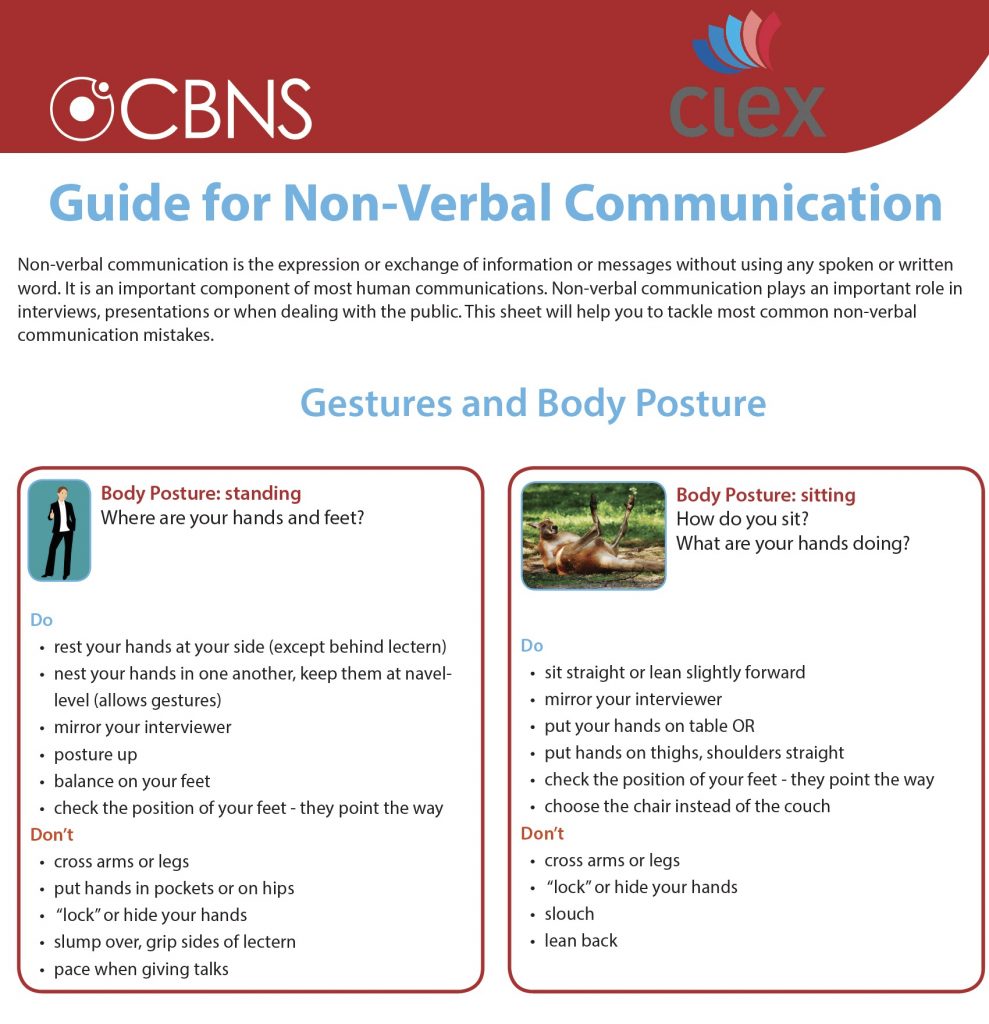In the world of print and radio, non-verbal communication may not matter, but when we turn to television, panel discussions, audience presentations and even job interviews then whether we sink or swim can depend on the non-verbal cues we put out. As part of our first-ever combined Centre of Excellence media communication workshop, Anne Meyer from the ARC Centre of Excellence in Convergent Bio-Nano Science and Technology produced this cheat sheet for non-verbal communication.
Click on the image below to download the pdf or read the contents below.
Guide for non-verbal communication
Non-verbal communication is the expression or exchange of information or messages without using any spoken or written word. It is an important component of most human communications. Non-verbal communication plays an important role in interviews, presentations or when dealing with the public. This sheet will help you to tackle the majority of common non-verbal communication mistakes.
GESTURES AND BODY POSTURE
Body Posture: standing (Where are your hands and feet?)
Do this
- rest your hands at your side (except behind lectern)
- nest your hands in one another, keep them at navel level (allows gestures)
- mirror your interviewer
- posture up
- balance on your feet
- check the position of your feet – they point the way
Don’t do this
- cross arms or legs
- put hands in pockets or on hips
- “lock” or hide your hands
- slump over, grip sides of lectern
- pace when giving talks
Body Posture: sitting (How do you sit? What are your hands doing?)
Do this
- sit straight or lean slightly forward
- mirror your interviewer
- put your hands on table OR
- put hands on thighs, shoulders straight
- check the position of your feet – they point the way
- choose the chair instead of the couch
Don’t do this
- cross arms or legs
- “lock” or hide your hands
- slouch
- lean back
Gestures (Accentuate the message and show emphasis, openness, warmth)
Do this
- use calm gestures
- open palms are better than pointy fingers
- posture up
Don’t do this
- fidget
- draw words
EYE CONTACT & FACIAL EXPRESSIONS
Eye contact (Maintain eye contact = confidence)
Do this
- focus on the bridge of the nose rather than eyes
- pause briefly before answering questions
- shift eye contact in group interviews
Don’t do this
- stare
- wander around
Facial Expression (First we see, then we hear)
Do this
- smile
- remind yourself to not look angry
- practice in front of a mirror
Don’t do this
- fail to express any emotions (robot)
- frown
Paralinguistics 1 (Voice, tone, speed and volume)
Do this
- keep your voice/tone level and well-modulated
- place emphasis in your words
- record yourself
- try speaking while writing
Don’t do this
- whisper (only use as a special effect)
- shout
Paralinguistics 2 (Inflection and uptalk)
Do this
- be aware of your voice
- put certainty behind your statement
- practice at home with commands “Pen, move to the right!”
Don’t do this
- use inflection at the end of a sentence
- use upspeak unless asking a question
Filling words, sounds and phrases (We use fillers when our words get ahead of our thoughts)
Do this
- slow down
- be aware – count or clap
- breathe and pause – better a second of silence than “um” or “er”
- prepare – filler word usage is highest when preparation is lowest
- shift focus
Don’t do this
- speak too fast
- use basically, actually, like, um, uh, ah, mmhh, literally, you know, what I am trying to say is

